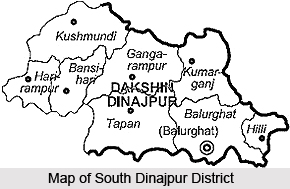 Education in the South Dinajpur district is in quite a developed state. Though the district has many problems such as overwhelming dependence on agriculture, unemployment due to lack of industries, a long international border and poor communication, the literacy rate in the district is an impressive 64.46 percent. The primary and elementary education scenario has been undergoing a positive change due to the implementation of the District primary education programme since 2000-2001. New school buildings and additional class rooms are being provided under DPEP so that adequate space is available to all schools which shall help in bringing a substantial portion of out of school children in to the main stream. Community mobilization programmes for primary teachers have already been completed. Through increasing enrolment and retention and emphasizing on quality education under DPEP, this district is progressing steadily toward the desired goal of Universal Elementary Education. Among the various educational institutions in the district, there are to be found 1311 primary schools, 185 upper primary schools, 4 degree colleges and 1 technical school.
Education in the South Dinajpur district is in quite a developed state. Though the district has many problems such as overwhelming dependence on agriculture, unemployment due to lack of industries, a long international border and poor communication, the literacy rate in the district is an impressive 64.46 percent. The primary and elementary education scenario has been undergoing a positive change due to the implementation of the District primary education programme since 2000-2001. New school buildings and additional class rooms are being provided under DPEP so that adequate space is available to all schools which shall help in bringing a substantial portion of out of school children in to the main stream. Community mobilization programmes for primary teachers have already been completed. Through increasing enrolment and retention and emphasizing on quality education under DPEP, this district is progressing steadily toward the desired goal of Universal Elementary Education. Among the various educational institutions in the district, there are to be found 1311 primary schools, 185 upper primary schools, 4 degree colleges and 1 technical school.
In the year 1993, a literacy movement was started in the South Dinajpur district. It was decided that a Total Literacy Campaign (TLC) would be launched in the district to eradicate illiteracy of the people belonging to the age group of 8+ to 40 years. A survey was conducted in each Block and Municipal area. The extensive Block and Municipality wise survey found the number of target illiterate population as 3, 83,990. A total of 31,482 learning centres were opened all over the district. Out of 3, 83,990 illiterates identified by local survey, 2, 20,251 were enrolled and made literate through TLC.
The plan for Post Literacy Programme (PLC) was approved in 1998. Learning centres for Post Literacy Programme were opened in January, 2000. Total numbers of learners enrolled were 75,326. The left-out learners and drop-outs were motivated and enrolled in the TLC side-by-side with the PLC. Out of 75,326 learners of PLP enrolled, 39,379 passed in external evaluations held on 24.2.2001 conducted by SRC Odisha and DDZSSS (Dakshin Dinajpur Zilla Sarbik Saskharata Samity).
The literacy movement influenced the life of the people in various ways directly and indirectly. Enrolment in pre-school increased by 26000 which is considered more than the usual increase of 11 percent per year. This has become a common feature in subsequent years. Tremendous response was observed during immunization programme in the district due to health awareness created through TLC/PLC. A positive attitude towards education has built up among the people of the district. Awareness about the utility and scope of the education has increased among the people of backward classes specially Women, SC, ST and Minority communities.



















